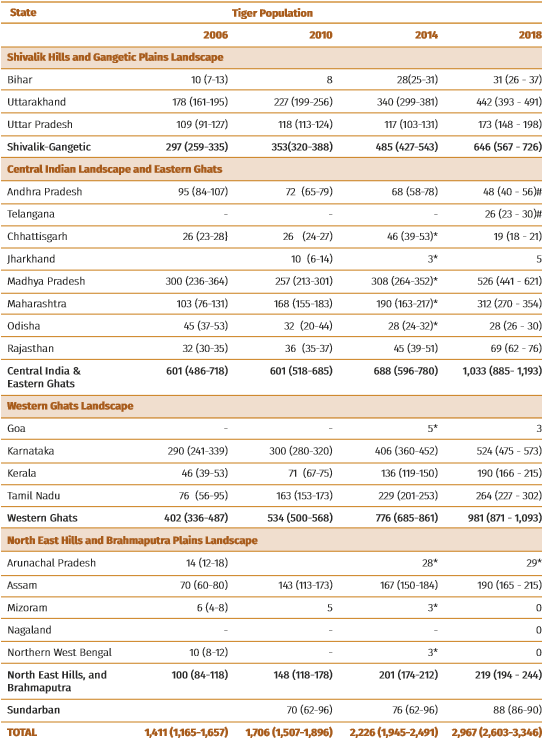Tiger is our national and culture heritage and is therefore revered by many National as its National Animal. The success of India in conserving and doubling its wild tiger population in a span of about 12 years (much before the targeted year of 2022 as per St. Petersburg Declaration) is commendable especially when the tiger is highly threatened globally due to the high illegal demand of its body parts. The Fourth Cycle of all India Tiger Estimation has been successfully completed and has shown an increase in the tiger numbers. Most tiger range countries who were in a better economic position have failed to protect the tiger, the success in India is largely attributable to the people, culture and religious tolerance and reverence to all life forms that co-habit this planet with us. Specially applauded are the efforts of entire team of National Tiger Conservation Authority, Wildlife Institute of India and State forest department for this success. The recovery of tiger populations signifies recovering ecosystems and their life support systems that are so important for mankind in India and on the planet.
Tigers, the top predators in an ecosystem, are vital in regulating and perpetuating ecological processes. Ensuring the conservation of this top carnivore guarantees the well-being of forested ecosystems, the biodiversity they represent as well as water and climate security. However, the rise in organized poaching driven by an international demand for tiger parts and products, depletion of tiger prey and habitat loss have led to largely disconnected fragmented populations. Extant tiger populations are confined to less than 7% of their historical range in patchily distributed habitats across a range of 12 regional tiger conservation landscapes (TCLs) in southern, northern, and south-eastern Asia (Dinerstein et al. 2007). Of these, six global priority TCLs for long-term tiger conservation significance are present in the Indian subcontinent alone. Home to more than 80% of the global population of 3,159 adult free-ranging tigers (Goodrich et al. 2015) and harboring >60% of the global genetic variation in the species (Mondol et al. 2009), India plays a crucial role in accomplishing the objectives of the Global Tiger Recovery Plan that was ratified at the meeting of world leaders held at St. Petersburg (Russia) in 2010.
In India, tigers inhabit a wide variety of habitats ranging from the high mountains, mangrove swamps, tall grasslands, to dry and moist deciduous forests, as well as evergreen and shola forest systems. By virtue of this, tiger is not only a conservation icon but also acts as an umbrella species for majority of eco-regions in the Indian subcontinent. On the other hand, tigers need large undisturbed forested landscapes with ample prey to raise young and to maintain long-term genetic and demographic viability (Seidensticker et al. 1993, Karanth and Sunquist 1995). In a country with an increasing demand for land by an evergrowing population, conserving such a large carnivore demands innovative approaches to land use planning that maintains connectivity between tiger source populations in a metapopulation framework. The Project Tiger, that was initiated in 1973 aimed to harness the functional role of the tiger and its charisma to garner resources and public support for conserving representative ecosystems. Under the stewardship of Project Tiger, the initial number of nine tiger reserves ( 18,278 km ) has now expanded to 50 tiger reserves ( 72,749 km ) covering about 2.21% of India’s geographical area. Nevertheless, many Tiger Reserves and Protected Areas in India are analogous to small islands in a vast sea of ecologically unsustainable land uses of varying degrees. Many tiger populations are confined within small Protected Areas and some have habitat corridors that permit tiger movement between them. However, most of the corridor habitats in India are not protected areas, and are degrading due to unsustainable human use and developmental projects.
For conservation purposes, the country was divided in five tiger occupied landscape complexes having unique geographical features and tiger populations :
- Shivalik and the Gangetic Plains landscape extends across the states of Uttarakhand, Uttar Pradesh and Bihar.
- Central Indian and Eastern Ghats landscape extends across the states of Rajasthan, Madhya Pradesh, Chhattisgarh, Jharkhand, Maharashtra, Telangana, Andhra Pradesh, and Odisha.
- Western Ghats landscape extends across the states of Karnataka, Tamil Nadu, Goa, and Kerala.
- North Eastern Hills and Brahmaputra Flood Plains landscape extends across parts of Northern West Bengal, Assam, Arunachal Pradesh, Mizoram, Nagaland.
- Sundarban landscape comprises of the mangrove forests of southern part of West Bengal and extends into Bangladesh.


